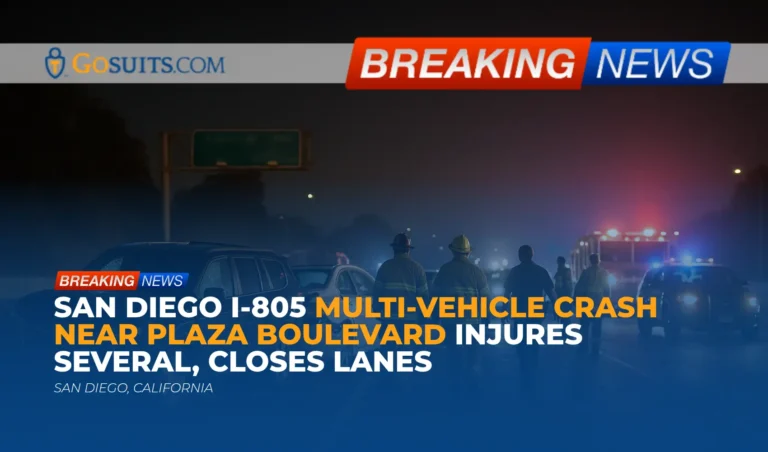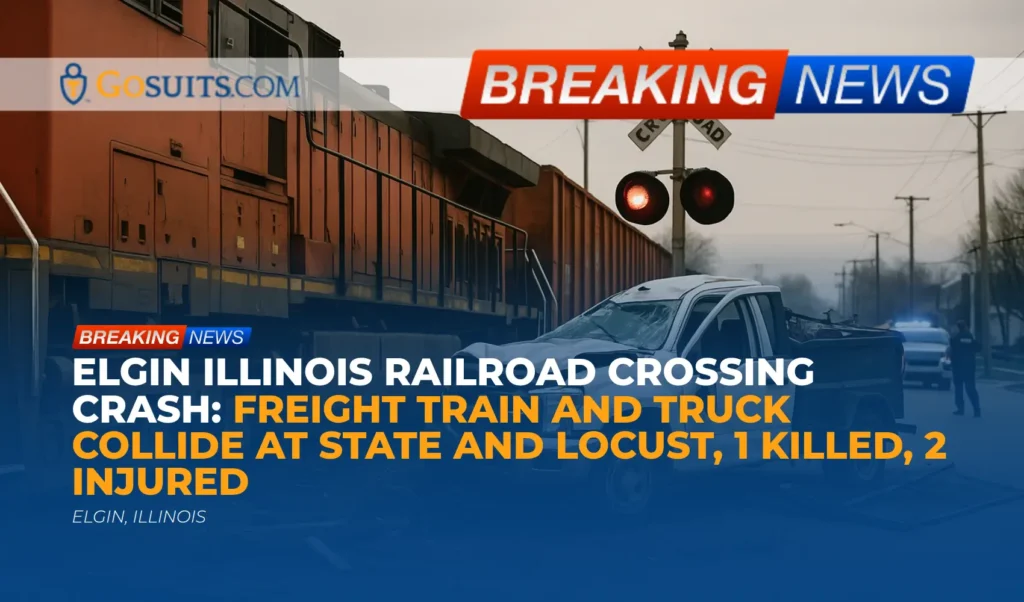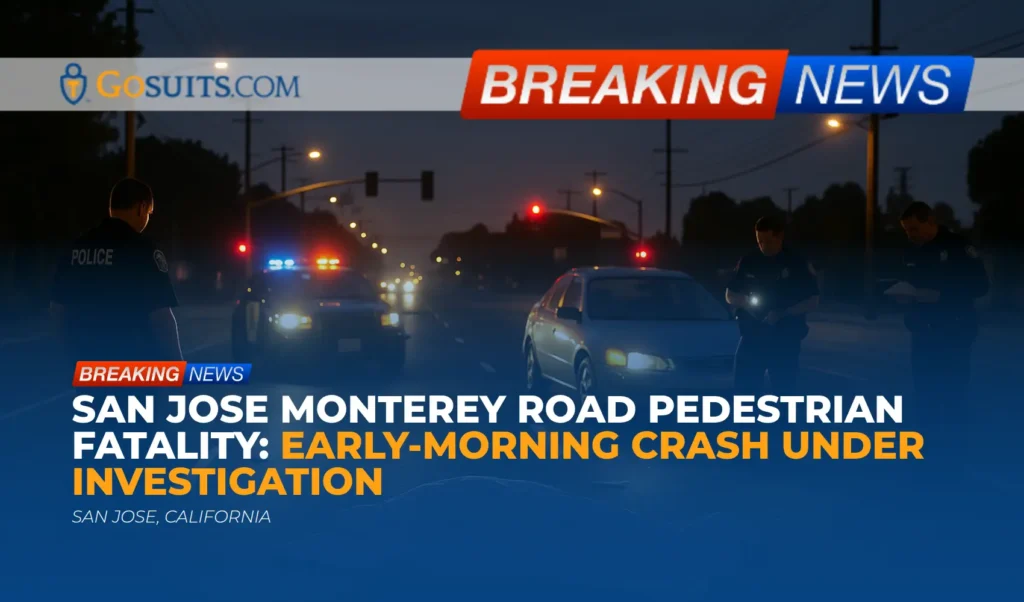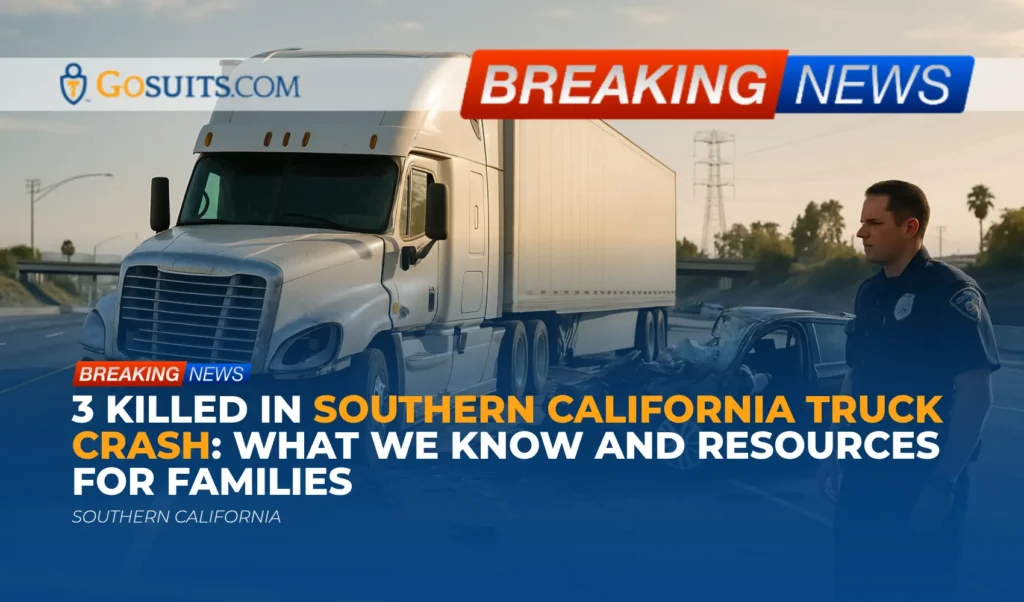- Overview of the I-805 Multi-Vehicle Crash Near Plaza Boulevard
- What Is Known So Far
- About the Location: I-805 Near Plaza Boulevard
- Injuries, First Response, and Scene Management
- How Highway Crashes Are Investigated and Why Lanes Close
- Key Legal Rights After a Multi-Vehicle Crash in California
- Potential Liability in Multi-Vehicle Highway Collisions
- Insurance Considerations and Communication Tips
- Evidence to Preserve and How to Document the Claim
- Where to Get Official Records: Police Report, Medical Examiner, 911, and More
- Deadlines and Time Limits That May Apply
- Safety Notes: Nighttime Crashes and Good Samaritan Protections
- Practical Next Steps After a Crash Like This
- Commentary from Gosuits San Diego, California Personal Injury Attorney
- Action Steps and Why Acting Promptly Matters
Overview of the I-805 Multi-Vehicle Crash Near Plaza Boulevard
Late Friday night on October 17, 2025, several people were injured in a multi-vehicle collision on northbound Interstate 805 near Plaza Boulevard in San Diego. According to information attributed to the California Highway Patrol, the crash occurred at approximately 11:20 p.m. A dark SUV reportedly struck the right-hand shoulder wall. Multiple drivers stopped to render aid before emergency personnel arrived. The incident was initially classified by responding officers as a major crash and later categorized as involving minor injuries.
First responders located a man unresponsive inside one of the vehicles, initiated extraction and medical care, and transported him to a nearby hospital. Multiple lanes were closed while tow operators removed damaged vehicles and authorities investigated. As of the latest reporting, the precise number of vehicles and the sequence of impacts have not been publicly detailed.
This article offers compassionate, fact-based information for community members seeking to understand what happened and what steps are commonly taken after a serious freeway crash. It also provides general legal context, sources of official records, and practical considerations for those affected by collisions of this nature.
What Is Known So Far
Time and place
The collision took place on northbound I-805 near the Plaza Boulevard area of San Diego at about 11:20 p.m. on Friday, October 17, 2025. This section of I-805 is a busy artery connecting South Bay and central San Diego neighborhoods.
Vehicles and immediate aftermath
Reports indicate a dark SUV hit the right-hand shoulder wall. Other motorists stopped and attempted to assist until first responders took over. CHP officers initially labeled the crash as major but later confirmed that injuries were categorized as minor overall, with at least one patient initially found unresponsive and transported for care.
Lane closures and towing
Authorities closed multiple lanes to conduct the on-scene investigation and allow tow operators to clear the wreckage. These closures are standard for multi-vehicle collisions to ensure safety and to document the scene.
Status of investigation
The investigation will typically examine vehicle positions, roadway evidence, and statements from involved parties and witnesses. No official public determination of fault has been shared to date. For updates or confirmation, the California Highway Patrol is the primary point of contact for freeway crashes in this corridor. See the CHP website at chp.ca.gov.
About the Location: I-805 Near Plaza Boulevard
Interstate 805 is a north–south freeway serving the San Diego metropolitan area. The Plaza Boulevard vicinity is a heavily traveled segment with multiple lanes, on-ramps, and off-ramps. Nighttime traffic tends to be lighter than daytime volumes, but visibility and speed can vary widely. The combination of speed, lighting conditions, and driver behavior can elevate the risk of follow-on impacts after an initial crash or vehicle contact with a barrier.
Caltrans maintains statewide traffic monitoring and lane closure information through QuickMap, which can be useful to understand the timing of incident-related closures and detours at quickmap.dot.ca.gov.
Injuries, First Response, and Scene Management
In this incident, an unresponsive man was located in one vehicle, extracted by responders, and transported to a hospital. Others were evaluated for injuries categorized as minor. Any level of head, neck, or internal trauma can be serious; people sometimes downplay symptoms immediately after a crash due to adrenaline or shock.
Emergency response on California freeways typically involves CHP for traffic control and investigation, city or county fire-rescue for extraction and medical care, and contracted tow services to clear vehicles. The Federal Highway Administration describes the importance of traffic incident management to protect responders and the public during freeway incidents; see the FHWA overview at ops.fhwa.dot.gov/eto_tim_pse/tim.htm.
How Highway Crashes Are Investigated and Why Lanes Close
After a multi-vehicle collision, authorities secure the scene, provide medical care, and prevent secondary crashes. Lanes may close so investigators can photograph damage, measure skid marks and debris fields, capture dashcam or traffic camera angles where available, and identify witnesses. Tow operators then remove disabled vehicles and roadway hazards.
CHP maintains incident logs and collision reports. The public can monitor current incidents using CHP’s public incident page at cad.chp.ca.gov, though not every detail is published in real time. Official collision reports are generally released upon request once complete.
Key Legal Rights After a Multi-Vehicle Crash in California
California is a fault-based state for auto collisions. In general terms, a person injured in a crash caused by another driver may pursue compensation from that driver’s liability insurance for medical expenses, wage loss, and other legally recognized harms. California applies comparative fault principles: if more than one party is partly responsible, responsibility may be apportioned among them. The comparative fault concept appears in the California Civil Jury Instructions; see the Judicial Branch’s CACI materials (Comparative Fault is addressed in CACI 405) at courts.ca.gov.
If a roadway defect or missing/failed traffic control device contributed to a crash, claims involving a public entity may also be considered. Such claims have special notice deadlines under California’s Government Claims Act. For a general reference to the six-month claim presentation requirement, see Government Code section 911.2 at leginfo.legislature.ca.gov.
Nothing in this article is a guarantee of outcome; every case turns on its specific facts, documentation, and applicable law.
Potential Liability in Multi-Vehicle Highway Collisions
When a vehicle first strikes a barrier or becomes disabled, nearby drivers may have very little time to react, especially at night. Potential liability pathways can include:
- The driver who initiated contact with the wall or barrier if unsafe speed, distraction, impairment, or other negligence caused loss of control.
- Following drivers whose speed, tailgating, or inattention contributed to secondary impacts.
- Third parties if a vehicle defect or improper repair contributed to the crash sequence.
- Public entities in limited circumstances if a dangerous condition of public property was a substantial factor, subject to immunities and strict notice requirements.
Ultimately, fault can be shared. California’s comparative fault framework allows partial responsibility to be assigned to multiple parties, affecting how damages are allocated. For a general reference to the jury instructions resource maintained by the California Courts, visit courts.ca.gov.
Insurance Considerations and Communication Tips
After a freeway collision, insurance carriers often reach out quickly. It is common to feel pressure to give a recorded statement or accept an early settlement before the medical picture is clear.
- Consult an attorney before speaking with any insurer, including your own. Statements can be used to limit or dispute a claim later.
- Medical Payments (MedPay) coverage, if available on your policy, may help with immediate medical bills regardless of fault. Review coverage documents to understand limits and reimbursement provisions.
- Uninsured/Underinsured Motorist (UM/UIM) coverage may apply if the at-fault driver lacks adequate insurance.
- Property damage claims can proceed while medical issues are still developing, but do not sign broad releases that could affect your injury claim.
California requires drivers to report crashes to the DMV if there is an injury, death, or property damage over the statutory threshold by filing form SR-1 within 10 days. See the DMV’s accident reporting page at dmv.ca.gov.
Evidence to Preserve and How to Document the Claim
In multi-vehicle crashes, timely evidence preservation can make a meaningful difference. Consider the following documentation steps, understanding that each situation is unique:
- Medical records and follow-up: Keep copies of ER discharge notes, imaging studies, prescriptions, and follow-up care. Attend recommended treatment and document symptoms over time.
- Scene and vehicle photographs: Photos or video of the scene, debris, vehicle damage, and any interior airbag deployments help reconstruct dynamics.
- Witness information: Names and contact details of bystanders who stopped to help can be invaluable.
- Vehicle data: Modern vehicles store event data (EDR). Prompt preservation can be important in multi-vehicle claims.
- Work and income documents: Save pay stubs, timesheets, and employer letters to substantiate wage loss.
- Out-of-pocket expenses: Track mileage to appointments, medical co-pays, and other crash-related costs.
If a vehicle will be totaled or salvaged, ensure the opportunity to inspect and download data before disposal. Document where the vehicle is stored and who controls access.

Where to Get Official Records: Police Report, Medical Examiner, 911, and More
California Highway Patrol collision report
Because this crash occurred on a state freeway, the CHP is generally the reporting agency. Collision reports are typically requested by involved parties, their insurers, or legal representatives through CHP processes. For contact and reporting information, visit the CHP website at chp.ca.gov. CHP also provides a public incident information page for current events at cad.chp.ca.gov.
San Diego County Medical Examiner (coroner) records
When crashes involve fatalities, next of kin can request reports from the County of San Diego Office of the Medical Examiner. Information on records and procedures is available through San Diego County’s official site at sandiegocounty.gov and the Medical Examiner’s pages linked therein. Report types may include examination findings and toxicology when applicable.
911 audio, CAD logs, and public records
Certain records may be requested under the California Public Records Act (CPRA), subject to exemptions. The California Attorney General provides a plain-language overview of CPRA at oag.ca.gov. 911 recordings and dispatch logs can be time-sensitive due to retention policies; requests should be made promptly, identifying the date, time, and location.
DMV accident reporting requirement
California requires submission of an SR-1 to the DMV within 10 days for crashes involving injury, death, or property damage above the threshold. The DMV’s accident reporting information is at dmv.ca.gov. This DMV report is separate from the CHP collision report.
Caltrans traffic and lane closure data
For understanding lane closures and incident timing, Caltrans QuickMap provides real-time data and historical context for traffic flow and closures at quickmap.dot.ca.gov.
Rotation tow information
CHP manages a rotation tow program for clearing freeway incidents. Records of which tow company responded and vehicle storage locations may be available through CHP. Program information is on the CHP site at chp.ca.gov.
Deadlines and Time Limits That May Apply
- General personal injury limitation period: In California, most personal injury actions must be filed within two years of the date of injury. See Code of Civil Procedure section 335.1 at leginfo.legislature.ca.gov.
- Claims against public entities: If a claim may involve a public entity, a written claim generally must be presented within six months. See Government Code section 911.2 at leginfo.legislature.ca.gov.
- DMV SR-1 reporting: File within 10 days if there is an injury, death, or qualifying property damage. Details at dmv.ca.gov.
These timeframes can have exceptions or different rules depending on specific facts. Timely review of potential claims helps protect options.
Safety Notes: Nighttime Crashes and Good Samaritan Protections
Nighttime crashes often involve reduced visibility, glare, and higher speeds relative to traffic density. National Highway Traffic Safety Administration publications consistently note elevated risk in dark conditions. For general federal safety materials and data, see nhtsa.gov.
California law encourages citizens to render emergency care in good faith. Health and Safety Code section 1799.102 offers liability protection for individuals who, in good faith and not for compensation, provide emergency medical or nonmedical care at the scene of an emergency. See the code text at leginfo.legislature.ca.gov. This statute does not prevent claims against those whose separate negligence caused a crash; it aims to protect well-intentioned aid at the scene.
Practical Next Steps After a Crash Like This
Every situation is unique, but the following steps are commonly useful after a serious freeway collision:
- Seek medical evaluation promptly, even for seemingly minor symptoms. Document ongoing pain, mobility limits, headaches, or cognitive changes.
- Request the CHP collision report when available and verify accuracy. Supplement with your statement if needed.
- Preserve evidence including photos, video, witness contacts, and vehicle data.
- Keep a recovery journal noting pain levels, sleep disruptions, and activity limitations.
- Consult a qualified attorney before speaking with any insurance adjuster or giving a recorded statement. What is said early can affect the claim later.
- Avoid social media posts that could be misinterpreted regarding activities or recovery.
If a loved one was critically injured or worse, consider appointing a point person in the family to coordinate medical updates, records requests, and communication. This helps reduce stress and prevents missed deadlines.

Commentary from Gosuits San Diego, California Personal Injury Attorney
Our hearts are with everyone affected by the late-night collision on I-805 near Plaza Boulevard. Finding a loved one unresponsive at a crash scene is terrifying, and even so-called minor injuries can disrupt lives for months. The information here is provided for general educational purposes to help the community understand what typically follows a multi-vehicle freeway crash.
In a chain-reaction or multi-vehicle event, the first moments can determine everything: where vehicles come to rest, whether hazards are illuminated, and how quickly motorists behind can react in the dark. Investigations look not only at the driver who first hit the wall, but at following drivers’ speeds and spacing, and whether any roadway conditions made matters worse. It is common for responsibility to be shared. That is why comprehensive documentation — photos, statements, data downloads, and timely medical evaluations — matters from the start.
Insurance companies and large corporations manage claims constantly. They understand how small statements can be used to minimize responsibility, and how gaps in care or missing records can be framed as lack of injury. Adjusters may ask for a recorded statement quickly or offer an early settlement before doctors fully understand the injury. These tactics often leverage a person’s unfamiliarity with the process. Taking time to understand rights and options before signing documents or giving statements is critical.
A free consultation can be an important first step in understanding the landscape — how coverage applies, what evidence to preserve, and which deadlines are approaching — without pressure to make immediate decisions. Speaking with a seasoned, skilled advocate before engaging with insurers can help avoid missteps that limit future options.
Action Steps and Why Acting Promptly Matters
- Pin down the facts now: Incident logs, 911 audio, dashcam footage, and witness memories fade or are overwritten. Acting while evidence is still available strengthens the factual record.
- Protect health and recovery: Early medical evaluation documents injuries and guides proper care. Delays can complicate both recovery and the ability to connect injuries to the crash.
- Secure vehicle and data: Totaled vehicles are often moved or salvaged quickly. Ensuring access for inspection and event data downloads helps clarify crash dynamics and responsibility.
- Avoid harmful statements: Insurance interviews taken before consulting counsel can lock in narratives that overlook pain progression or future care needs.
- Track deadlines: California’s two-year limitation for injury claims and the shorter, six-month window for public entity claims are firm time bars. Early planning preserves options.
- Coordinate records: Obtaining the CHP report, medical records, and any coroner documentation if applicable reduces uncertainty and organizes the path forward.
Taking these steps promptly helps transform confusion into a clearer plan, supports medical recovery, and preserves the information needed to navigate insurance and potential claims with confidence.
Reliable Sources Referenced
- California Highway Patrol
- CHP Traffic Incident Information Page
- Caltrans QuickMap
- FHWA Traffic Incident Management
- California DMV Accident Reporting (SR-1)
- Code of Civil Procedure §335.1
- Government Code §911.2
- Health and Safety Code §1799.102
- California Courts (CACI Jury Instructions)
- California Public Records Act – Attorney General
- County of San Diego (Medical Examiner)
- National Highway Traffic Safety Administration






